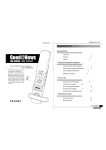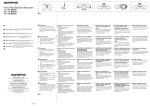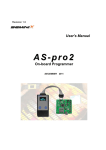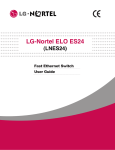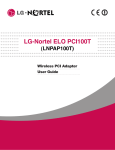Download 2JANE Olympus I100AF Owner's Manual
Transcript
INSTRUCTIONS Read this manual carefully before using your camera. WARNING Indicates circumstances under which mishandling resulting from ignoring this symbol could result in personal injury or property damage. KEEP THE BATTERIES AWAY FROM FIRE. NEVER TRY TO DISASSEMBLE, RECHARGE, OR SHORT-CIRCUIT BATTERIES. 2 KEEP THE BATTERY OUT OF THE REACH OF CHILDREN. IF A CHILD SWALLOWS A BATTERY, CONTACT A DOCTOR IMMEDIATELY. NEVER ATTEMPT TO DISASSEMBLE THE CAMERA; IT CONTAINS A HIGHVOLTAGE CIRCUIT. IF THE INTERNAL PARTS OF THE CAMERA ARE EXPOSED DUE TO DROPPING OR DAMAGE, REMOVE THE BATTERIES IMMEDIATELY TO PREVENT FURTHER USAGE. IN CASE OF MALFUNCTION, CONSULT YOUR NEAREST OLYMPUS DEALER OR OLYMPUS SERVICE CENTER. 3 Names of parts .................................. 5 Viewfinder display/LCD panel ............ 7 Cartridge ............................................ 8 Loading the battery ............................ 9 Checking the battery ........................ 10 Loading the cartridge film ................. 12 Taking pictures ................................. 13 Unloading the cartridge film ............. 14 Setting the print type ........................ 15 Print area on film .............................. 16 Using the Flash ................................ 17 Selftimer ........................................... 19 Care and storage ............................. 20 Specifications .................................. 24 4 NAMES OF PARTS Camera body Shutter release button AE light sensor* Autofocus window* Viewfinder Red-eye reduction lamp/selftimer signal Flash* Lens* Lens barrier switch Cartridge cover release *Do not soil as this can cause blurred pictures. Wipe clean with a soft cloth. 5 Print type selector switch Green lamp (ready-to-shoot indicator) Viewfinder LCD panel Strap eyelet Cartridge cover Selftimer button Flash mode button Mid-roll rewind button Tripod socket Battery compartment cover Battery compartment cover release Strap ring tip ATTACHING THE STRAP The camera strap ring tip can be used to press the mid-roll rewind button. 6 VIEWFINDER DISPLAY/ LCD PANEL Viewfinder Green lamp (ready-to-shoot indicator) Picture frame Autofocus frame LCD panel Fill-in mode (Forced Activation mode) Flash-Off mode Night Scene Flash mode Exposure counter Battery check Cartridge mark Film wind/rewind mark Red-Eye Reduction Flash mode Selftimer mode Auto Flash mode Notes: • The Viewfinder format changes in accordance with the print type selected (p. 15). • The LCD panel does not actually display all indications simultaneously as shown. 7 CARTRIDGE IX240 Cartridge Film Visual Exposure Indicator • Only cartridges with the (unexposed) visual exposure indicator can be used with this camera. • When a cartridge with other than the visual exposure indicator is loaded, the camera will rewind the film and set the cartridge to (exposed). • Take along plenty of film cartridges when traveling to foreign countries and other areas where cartridge purchasing may be difficult. • Do not forcibly move the visual exposure indicator because this may damage the cartridge. Using a damaged cartridge can result in camera trouble. 8 LOADING THE BATTERY Use one 3V lithium battery (CR2). 1. Slide the battery compartment cover release and open the cover 2. Load the battery and align the and ends correctly. 3. Turn the lens barrier switch to turn on the camera. Check the battery power on the LCD panel (p. 10). About 15 rolls of film can be used with one new 3V lithium battery (when the flash is used on half of pictures). Notes: • Dispose of used batteries in the battery recycling boxes at stores selling batteries. • if lithium batteries are not fully discharged, protect them against short-circuiting (e.g., by taping the contacts) before disposal. 9 CHECKING THE BATTERY Turn the lens barrier switch on the camera. to turn Display: lights. Meaning: Battery is OK. You can shoot. Display: lights. Meaning: Battery power is low and should be replaced with a new battery. Display: blinks. Meaning: Battery power is dead and should be replaced with a new battery. 10 Battery Handling • Observe the precautionary remarks written on the batteries. • When the camera is not used for an extended period of time, remove the battery. • Keep spare batteries on hand when going on a long trip or to a cold area. • Sweat, oil, and so on can prevent a battery's terminals from making electrical contact. To avoid this, wipe both terminals before loading the battery. 11 LOADING THE CARTRIDGE FILM Use unexposed negative-color IX240 cartridge film (ISO 100~400). 1. Make sure that is displayed on the camera's exposure counter. Turn the cartridge cover release to open the cartridge cover 2. Insert a cartridge with the (unexposed) visual exposure indicator and close the cartridge cover , The film will automatically advance to the first frame and"I" will appear in the 12 exposure counter • If starts blinking after the cartridge has been loaded, reload the cartridge. The battery must already be loaded before you load a cartridge. • If you remove the battery before the roll of film has been fully exposed, the exposure counter returns to . (You will be able to continue shooting, however.) TAKING PICTURES 1. Turn the lens barrier switch tto turn on the camera. 2. Look through the viewfinder and position the autofocus frame on your subject. 3. Press the shutter release button halfway to make sure the flash green lamp lights. (The focus and exposure are locked on the subject.) • When the green lamp is blinking, the flash is being recharged and the shutter cannot be released. 4. Compose the shot within the picture frame. Press the shutter release button to take the picture, • Working distance:0.9m(3ft)~ . • Always turn off the camera when you finish taking pictures. WARNING: SERIOUS EYE DAMAGE MAY RESULT FROM LOOKING DIRECTLY AT THE SUN THROUGH THE VIEWFINDER. 13 UNLOADING THE CARTRIDGE FILM 1. The film will be rewound automatically when the end of the roll is reached 2. Wait until the motor stops and "E" and the cartridge mark start blinking in the exposure counter. Then open the cartridge cover 3. Remove the cartridge .The cartridge visual exposure Indicator will be set to (exposed). •The camera will not operate until the rewound cartridge is removed. 4. To rewind the film before the end of the roll, press the mid-roll rewind button using the camera strap ring tip or anything equivalent. The cartridge will be set to (exposed). 14 SETTING THE PRINT TYPE Set the print type selector switch to the desired type: C, H or P. Print type selector switch C type viewfinder H type viewfinder P type viewfinder Always keep the print type selector switch set correctly. The print type setting is optically recorded on the film. The number of exposures does not change even when the print type is changed. 15 PRINT AREA ON FILM Print Type Setting Configuration c H P 16 Print type Aspect ratio C type Approx. 2:3 Approx. 9:16 Approx. 1:3 H type P type USING THE FLASH Press the flash mode button to select the appropriate mode for the shooting conditions or your requirements. 1. AUTO Auto Flash: This mode is used normally. The flash fires automatically in dark places. 2. AUTO Red-Eye Reduction: Minimizes the effect which causes eyes to appear red in pictures. 3. Flash Off: Use this mode when you do not want the flash to fire even in dark places. 4. Fill-In: Use this mode when you want the flash to fire regardless of lighting conditions. 5. Night Scene Flash: Lights the subject in the foreground with a night scene in the background. 17 • In the Flash Off and Night Scene Flash modes, use a tripod to prevent camera-shake. • When the flash mark is displayed on the LCD panel and the green lamp blinks, the flash is being recharged and the shutter does not release. • Turning off the camera restores the Auto Flash mode except when the camera is set to the Red-Eye Reduction Flash mode. ISO Flash Range 0.9~2.3 m (3~7.5 ft) 0.9 ~ 3.3m (3 ~ 10.8 ft) Using color negative film 200 400 18 SELFTIMER Attach the camera to a tripod or similar support. 1. Press the selftimer burton to display 2. Aim at your subject, and press the shutter release button . The selftimer signal will light, and the shutter will be released about 12 seconds later. The signal starts blinking right before the shutter releases. • When the green lamp is blinking, the flash is being recharged and the selftimer does not work. • To cancel the selftimer while operating, again press the selftimer button or turn the camera off. • Focus and exposure are locked when the selftimer button is pressed. Do not press the selftimer button while you are in front of the camera. 19 CARE AND STORAGE 1. Do not leave the camera in any place exposed to excessive heat, humidity, or direct sunlight — for example, in a car or on the beach. 2. Do not expose the camera to formalin or naphthalene. 3. If the camera gets wet, wipe it with a dry towel. The salt in seawater can be especially damaging. 4. Do not use organic solvents, such as alcohol or paint thinner when cleaning the camera. 20 5. Do not leave the camera on or near a television, refrigerator, or other appliance with a magnetic field. 6. Do not expose the camera to dust or sand as this could cause serious damage. 7. Do not shake or shock the camera. • Keep the camera in a well-ventilated place. • Do not expose the camera to extreme heat (over 40°C/104°F) or to extreme cold (below -5°C/23°F). Low temperatures, even within this range, may sometimes cause deterioration in battery performance, temporarily disabling the camera. 21 • When transporting the camera from a cold place to a warm place or in the event of a sudden temperature change, put the camera into a plastic bag. This allows the camera's temperature to change slowly. Once the camera has adjusted to the new temperature, you can remove it from the bag and use it. 22 • Avoid leaving the camera unused for long periods of time. This can cause mold to grow on the camera as well as other problems. Try to press the shutter release button and check the operation of the camera before use. • Some airport X-ray machines can damage the film in your camera. Try to avoid passing your camera through these machines. Give it to the security officer for manual inspection. • This camera is not suitable for professional use or for use under extreme conditions. 23 SPECIFICATIONS Type: Autofocus lens-shutter camera. Film format: IX240 cartridge film. Image size: 16.7 x 30.2 mm. Print type: Selection between C, H and P print types. Lens: Olympus lens, 24 mm F7,3 elements in 3 groups. Shutter: Programmed electronic shutter (1/200 ~ 1/3 sec). Viewfinder: Albada viewfinder 0.33X magnification. Shooting ready indicator (green lamp). Focusing: Active type autofocus with focus lock. Focus range: 0.9 m (3 ft) ~ . Exposure counter: Progressive type, reverses during rewind. Selftimer: Electronic selftimer with approx. 12 sec. delay. Cancellation is possible. Film speed: Automatic setting (ISO 100, 200 and 400). 24 Film loading: One-touch insertion, automatic loading (automatically advanced to first frame when cartridge cover is closed}. Film advance: Automatic film winding. Film rewind: Automatic rewind at end of roll. Mid-roll rewind also possible. Rash: Built-in flash. Flash modes: Auto Flash (automatic activation in low light), Red-Eye Reduction Flash, Flash-Off, Fill-in and Night Scene Flash. Data recording: Optical recording system (print type information only) Power source: One 3V lithium battery (CR2). Dimensions: 123 (W) x 50 (H) x 36 (D) mm (4.8 x2x1.4in). Weight: 135 g (4.8 oz) (without battery). Design and specifications are subject to change without notice. 25 OLYMPUS OPTICAL CO., LTD San-Ei Building, 22-2, Nishi Shinjuku 1 -chome, Shinjuku-ku, Tokyo, Japan. Tel. 03-3340-2211 OLYMPUS AMERICA INC. Two Corporate Center Drive, Melville, NY 11747-3157, U.S.A. Tel. 1-800 "O" CAMERA(622-6372) OLYMPUS OPTICAL CO. (EUROPA) GMBH. (Premises/Goods delivery) Wendenstrasse 14-18, 20097 Hamburg, Germany. Tel. 040-237730 (Letters) Postfach 10 49 08, 20034 Hamburg, Germany. OLYMPUS SINGAPORE PTE. LTD. 491B River Valley Road, #13-04 Valley Point Office Tower, Singapore 248373 Tel. 7387838/1 -800-OLYMPUS(6596787) OLYMPUS KOREA CO., LTD. 8F Central Banking Corporation Bldg., 826-20 Yoksam-dong, Kangnam-gu, Seoul 135-081 Korea. Tel. 02-3466-2910 Fax. 0081-3-3346-8380 Tel. 00852-2730-1505 Fax. 00852-2730-7976 This device complies with part 15 of the FCC Rules. Operation is subject to the conditions that this device does not cause harmful interference. This Class B digital apparatus meets all requirements of the Canadian Interference-Causing Equipment Regulations. This camera complies with EU directive 89/336/EEC for CE marking. CS0475 63139-400-OLY A 0201




























